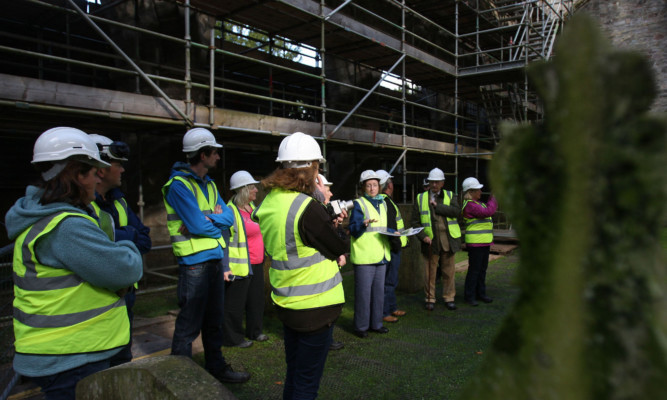Thousands of visitors make their way to Dunkeld each year to explore one of Perthshire’s finest buildings.
The town’s 14th Century cathedral is a mix of beautiful parish church and impressive ruin, having been partially destroyed in religious conflict.
Historic Scotland has been responsible for the building’s upkeep for years and has embarked upon a conservation project in a bid to preserve the damaged bell tower and cavernous nave.
As the work takes place, a unique opportunity to explore parts of the cathedral usually off limits to the public was offered to visitors on a series of special tours.
They gave participants the opportunity to climb on to the scaffolding surrounding the ruined parts of the building and view the specialist conservation work currently under way.
Stonemasons are now working on the north knave wall to repair the damage caused by weather and water ingression and restore the wall’s structural integrity to ensure it stands for hundreds of years to come.
The visitors were also offered an insight into the rich history of the building.
Dunkeld has long been known as Scotland’s most romantic cathedral, but its history is also one of conflict.
Its roots can be traced back to the 9th Century, when it emerged as an important religious centre for the early Celtic church.
In 849, Kenneth MacAlpin, king of the newly created kingdom of Alba, had St Columba’s relics brought from Iona to a newly built church at Dunkeld after repeated Viking raids on the island unsafe.
The ninth century Apostles Stone carved with 12 figures, which may represent Christ’s disciples survives as a testament to this early activity.
In fact, Dunkeld itself was to suffer Viking raids when the Norse warriors ventured up the River Tay and by the 10th Century the focus of the Scottish church had moved to Kilrymont, now St Andrews.
No building of this period survives as the present cathedral dates from 1318.
The nave and bell tower, dating from the 1400s, fell into ruin during the Protestant Reformation of 1560 but the 13th Century choir became the parish church and is used for regular Sunday worship to this day.
A number of interesting artefacts and carvings remain within both parts of the cathedral, with early 16th Century wall carvings in the bell tower and fine memorials in the choir.
They include an effigy of Alexander Stewart, Earl of Buchan, known as the Wolf of Badenoch.
The youngest son of King Robert II, he was charged with exerting royal authority over the area, which he did by terrorising the community, operating protection rackets and fathering up to 40 illegitimate children.
Together with the architectural history of the cathedral, there exists a surprisingly detailed written record of its early years.
A former canon of the cathedral, Abbot Alexander Myln of Cambuskenneth, wrote a history of the lives of the bishops of Dunkeld in 1555 in which he details the cathedral’s construction.
